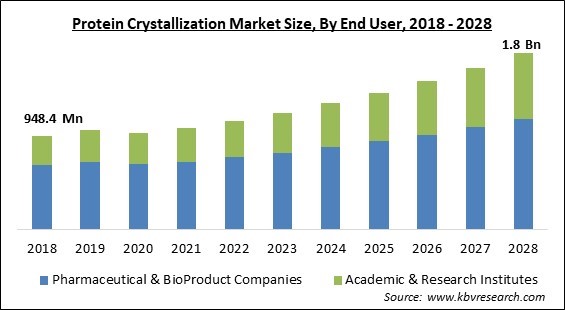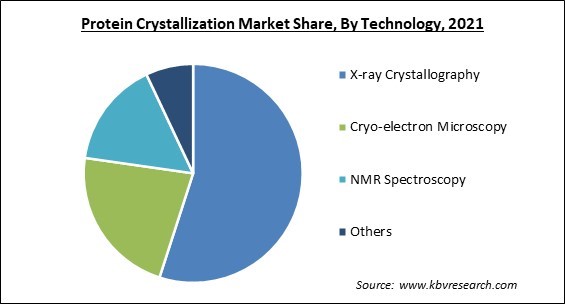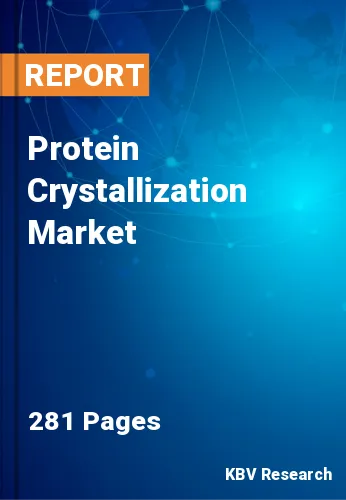The Global Protein Crystallization Market size is expected to reach $1.8 billion by 2028, rising at a market growth of 8.4% CAGR during the forecast period.
Protein crystallization is a process that produces protein crystals by introducing precipitating agents while keeping an eye on the solution's pH, temperature, and ionic strength. Utilizing x-ray diffraction crystallography to enhance structural biology research is one of the most important uses of crystallization. This method aids in the visualization of proteins' three-dimensional structures by researchers.

Moreover, crystallization is a successful technique for producing clean, pure proteins that are free of contamination, making it an option for preparative chromatography for separation and purification. As a result, the approach has several applications in the pharmaceutical, medicinal chemistry, scale-up, formulation, and drug delivery sectors.
Due to its advantages, such as minimal toxicity, high potency & specificity, and increased body tolerance, more people have started using protein-based medications in recent years. Important market participants are also forming alliances and working together to create protein-based medicines that are cheaper for patients.
The technology offers significant advancements in structural biology by allowing the examination of unstable proteins that cannot be investigated using other standard techniques. Such developments support the industry by assisting researchers in creating new and improved protein crystal treatments for conditions ranging from cancer to muscular dystrophy.
The market is being driven by an increase in R&D spending by several large pharmaceutical companies and an increase in the usage of crystallization for elucidating membrane protein structures. Moreover, underdeveloped nations like Brazil, China, and India provide the abundant potential for prominent protein crystallization and crystallography market participants.
Protein crystallography may be used to pinpoint the mutations linked to the new coronavirus. To increase the knowledge of the disease's immunogenicity, crystal structures of the SARS-CoV-2 spike are co-crystallized with antibodies. As a result of the increasing use of crystallographic methods for COVID-19-related research, COVID-19 had a favorable effect on the market. As the prevalence of infectious disorders among the population increased, so did the need for vaccines and protein-based treatments to treat the infection. Therefore, COVID-19 significantly influenced the development of the protein crystallization business. The market has expanded due to the increased usage of protein crystallization in the effect of COVID-19 medications.
Protein therapies have grown to be a crucial component of the healthcare sector. Because of their great specificity and minimal immunogenicity, protein therapies have been extensively employed to treat various severe disorders, including cancer, diabetes, and multiple sclerosis. Moreover, protein therapies offer several benefits over small-molecule medications and are well tolerated since they are less likely to interfere with normal biological processes. Throughout the last several decades, there has been significant growth in the demand for protein therapies, primarily due to the growing incidence of chronic illnesses and greater public knowledge of protein therapeutics.
Due to people's unhealthy lifestyles, the incidence of many chronic illnesses is increasing globally and is expected to do so in the future. According to the WHO, cancer will account for close to 10 million fatalities in 2020, or close to one in every six deaths, making it the top cause of death globally. Breast, lung, colon, rectum, and prostate cancers are the most prevalent types of cancer. In addition, 400 000 kids are diagnosed with cancer in youngsters every year. Due to this, the market for protein crystallization is projected to increase significantly throughout the forecast period.
Scientists utilize cutting-edge methods like X-ray crystallography and nuclear magnetic resonance spectroscopy to learn more about the structure of proteins. However, throughout the projected period, high initial expenses related to equipment installation and operation that are necessary for these approaches are anticipated to impede market development. Also, it is expected that a shortage of experienced researchers and qualified experts would have a limited negative influence on market growth throughout the projection period. Also, the lack of a defined procedure for protein crystallization may somewhat constrain market development throughout the projection period.
Based on product, the protein crystallization market is segmented into instruments, consumables and software & services. Software is employed during crystallization experiments, including design, dispensing, analysis, and picture viewing. For instance, the FORMULATRIX program ROCK MAKER enables the rapid creation of many screen assays for one or more proteins. It also gives ratings and aids in the comparison of the collected photographs. Such software capabilities are anticipated throughout the projected period to fuel sector expansion. Also, several businesses are providing protein crystallization services, which are expected to support the segment's growth.

On the basis of technology, the protein crystallization market is fragmented into x-ray crystallography, cryo-electron microscopy, NMR spectroscopy and others. In 2021, the cryo-electron microscopy segment recorded a remarkable revenue share in the protein crystallization market. Cryo-electron microscopy has several advantages over more established techniques like NMR and X-ray crystallography, including the ability to study proteins and their complexes of large molecules without the need for crystals, the reduction of radiation damage, and the ability to preserve post-translational modifications as well as the functional state and native activity of the samples.
By end-user, the protein crystallization market is categorized into pharmaceutical & bioproduct companies and academic & research institutes. The pharmaceutical & bioproduct companies segment held the highest revenue share in the protein crystallization market in 2021. Protein crystallization techniques play two key functions in structural biology, including in silico drug design and controlled drug discovery. The 3-D structure of a molecule is determined through protein crystallography used in in-silico drug creation. More precise 3-D protein structures are produced as a consequence of protein crystallization. These high-quality crystals may help pharmaceutical and biotechnology firms better understand biological function and improve medication design.
| Report Attribute | Details |
|---|---|
| Market size value in 2021 | USD 1 Billion |
| Market size forecast in 2028 | USD 1.8 Billion |
| Base Year | 2021 |
| Historical Period | 2018 to 2020 |
| Forecast Period | 2022 to 2028 |
| Revenue Growth Rate | CAGR of 8.4% from 2022 to 2028 |
| Number of Pages | 281 |
| Number of Table | 520 |
| Report coverage | Market Trends, Revenue Estimation and Forecast, Segmentation Analysis, Regional and Country Breakdown, Companies Strategic Developments, Company Profiling |
| Segments covered | Technology, Product, End User, Region |
| Country scope | US, Canada, Mexico, Germany, UK, France, Russia, Spain, Italy, China, Japan, India, South Korea, Singapore, Malaysia, Brazil, Argentina, UAE, Saudi Arabia, South Africa, Nigeria |
| Growth Drivers |
|
| Restraints |
|
Region wise, the protein crystallization market is analyzed across North America, Europe, Asia Pacific, and LAMEA. In 2021, the North America region led the protein crystallization market by generating largest revenue share. Increased investments in private businesses, government support, and advantageous rules might be blamed for this high percentage. The sector places much emphasis on research being done in the fields of drug discovery and proteomics structure prediction, which is what drives the market's expansion. Higher product penetrations in the area are the outcome of the existence of innovators and critical operational players.
Free Valuable Insights: Global Protein Crystallization Market size to reach USD 1.8 Billion by 2028
The market research report covers the analysis of key stake holders of the market. Key companies profiled in the report include Bruker Corporation, Corning Incorporated, Mettler-Toledo International, Inc., Greiner Bio-One International GmbH (Greiner AG), Rigaku Holdings Corporation, Formulatrix, Inc., Hampton Research Corp., Jena Bioscience GmbH, Creative Proteomics, and Molecular Dimentions Ltd (Anatrace Products LLC)
By End User
By Technology
By Product
By Geography
The global Protein Crystallization Market size is expected to reach $1.8 billion by 2028.
Increasing incidence of chronic illnesses are driving the market in coming years, however, Costly equipment restraints the growth of the market.
Bruker Corporation, Corning Incorporated, Mettler-Toledo International, Inc., Greiner Bio-One International GmbH (Greiner AG), Rigaku Holdings Corporation, Formulatrix, Inc., Hampton Research Corp., Jena Bioscience GmbH, Creative Proteomics, and Molecular Dimentions Ltd (Anatrace Products LLC).
The X-ray Crystallography segment acquired maximum revenue share in the Global Protein Crystallization Market by Technology in 2021 thereby, achieving a market value of $949.1 million by 2028.
The North America market dominated the Global Protein Crystallization Market by Region in 2021, and would continue to be a dominant market till 2028; thereby, achieving a market value of $594.8 million by 2028.
Our team of dedicated experts can provide you with attractive expansion opportunities for your business.

